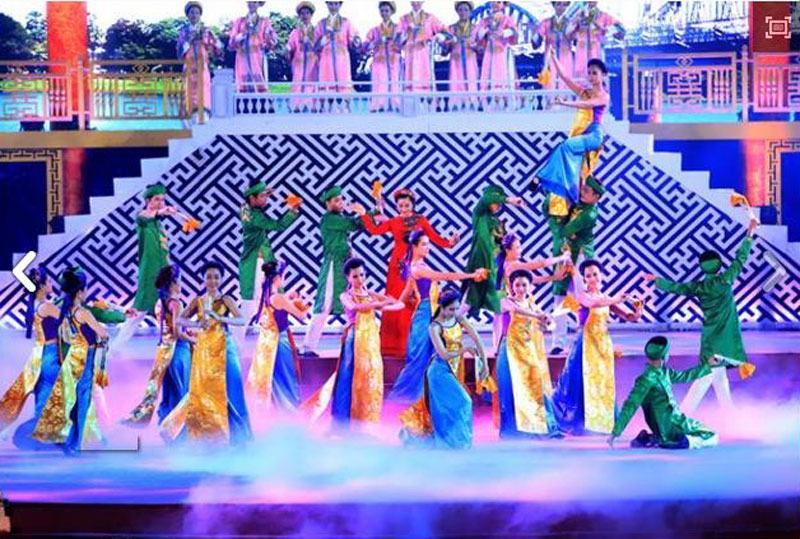
The Hue Festival 2018 came to an end on May 2, following a vibrant closing night featuring Hue’s royal court music performances and firework shows.
This year’s festival was held in the central province of Thua Thien-Hue from April 27 to May 2,
attracting thousands of visitors.

An performance at the closing night of Hue Festival 2018.
(Photo: VNA)
The 10th
edition of Hue Festival, an important event of the ancient imperial capital,
wrapped up after six days of exciting and impressive activities, said Nguyen
Dung, Vice Chairman of the provincial People’s Committee at the closing
ceremony.
The Hue
Festival 2018 offered stages for 786 performers representing 20 countries and
territories including Vietnam.
Audiences were provided chances to enjoy 72 stage shows as well as take part in
37 community activities held by local residents.
It aimed
to celebrate 712 years since the founding of Thuan Hoa - Phu Xuan, which is Hue today. The festival
was themed ‘Cultural Heritage with Integration and Development: Hue - One Destination,
Five World Heritages’.
The five
heritage statuses were awarded to the Complex of Hue Monuments, Hue royal court music, woodblocks, the imperial archives
of the Nguyen Dynasty and royal literature on Hue royal architecture.
"Van hien
kinh ky”, a highlight of the festival,was an art show which combined a
variety of elements: dance, chorus, animation, poem reciting and music. The
90-minute show featured all cultural values of Hue through heritage elements.
Meanwhile,
a show, titled "Am vong Song Huong” (Resonance of Perfume River), on April 29
involved hundreds of professional and amateur actors and actresses, depicting
the life cycle of people living on the rivers from their marriage, giving birth
and raising children to passing down their occupation from generation to
generation in a joint effort to preserve Hue cultural values.
The same
day, streets in the silent city of Hue
were bustling with performances by art troupes in a street parade. The art
troupes from countries and territories, including Japan,
the Republic of Korea,
Thailand, Mongolia, Belgium,
Poland and Slovakia,
brought their native colours to the streets. Audiences enjoyed their
performances, which demonstrated their circus skills, along with dance and
music, and displayed their costumes.
An "Ao
dai” show took place on May 1 evening, exhibiting exhibited collections of the
Vietnamese national long dress. The show, titled"The Heyday of Hue”, was
aimed at depicting"ao dai”in Hue
in different eras, with a focus on those worn during the imperial time under
the rule of the Nguyen Dynasty (1802-1945).
The
designers, hailing from different regions in the country, attempted to get
closer to Hue
by using symbolic patterns of the city on their designs, besides mimicking the
attires of royals and nobles.
Hue city
was the imperial capital of Vietnam
for hundreds of years. It is home to five UNESCO-recognised heritages, namely
the Hue ancient citadel relic complex – a World Cultural Heritage site; Nha
Nhac (Hue royal court music) - an intangible cultural heritage item; Nguyen
Dynasty’s wood blocks – a documentary heritage item; Nguyen Dynasty’s Chau ban
(royal administrative documents) – part of the Asia-Pacific Register of
UNESCO’s Memory of the World Programme; and literature on Hue royal
architecture - a documentary heritage.
Source: VNA
Hoa Binh province has carried out multiple programmes and initiatives to revive its cultural heritage which has gradually fallen into oblivion through the ebbs and flows of history.
The most prominent and defining feature in the prehistoric era of Hoa Binh is the Hoa Binh Culture. The Culture was first discovered in Hoa Binh. The significant prehistoric culture represents not only Vietnam but also Southeast Asia and southern China. Through excavations of cave sites in the limestone regions of Hoa Binh, French archaeologist M. Colani introduced the world to a "Stone Age in Hoa Binh province – Northern Vietnam" in 1927. On January 30, 1932, the First Congress of Far Eastern Prehistorians, held in Hanoi, officially recognised the Hoa Binh Culture.
Known as the "Land of Epic History”, Hoa Binh province, the gateway to Vietnam’s northwest, boasts a strategic location and a unique cultural tapestry woven by its ethnic minority communities.
The People's Committee of Luong Son District recently held a ceremony to receive the certificate recognizing Sau Communal House in Thanh Cao Commune as a provincial-level historical and cultural site.
Recognising the importance of cultural heritage preservation in protecting and promoting the value system of Vietnamese culture, and serving socio-economic development in the new period, Party committees and local administrations in Hoa Binh province have identified it as a key task in the cultural development strategy. The province has been making efforts in mobilising resources, creating consensus among people and engaging ethnic communities in preserving and promoting cultural identity.
Hoa Binh province has captured growing attention both domestically and internationally for its distinctive cultural heritage and rich history. Most notably, it has been renowned for its famous Hoa Binh culture, considered the cradle of ancient Vietnamese civilisation. Looking ahead to significant milestones in 2025 and the 140th anniversary of province establishment in 2026, Hoa Binh Newspaper presents a comprehensive overview of the province's development across economic, social, cultural, tourism, and security domains.



